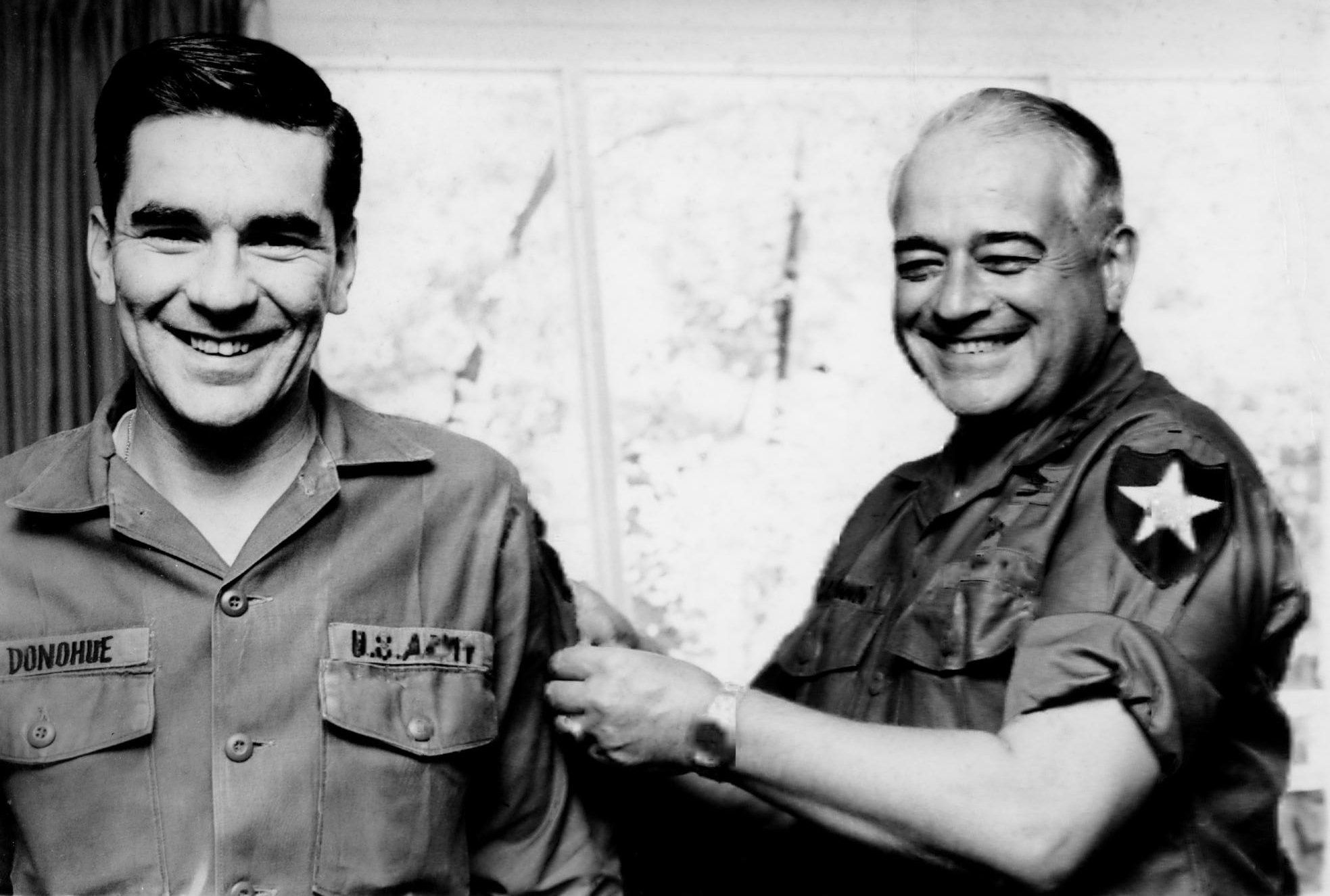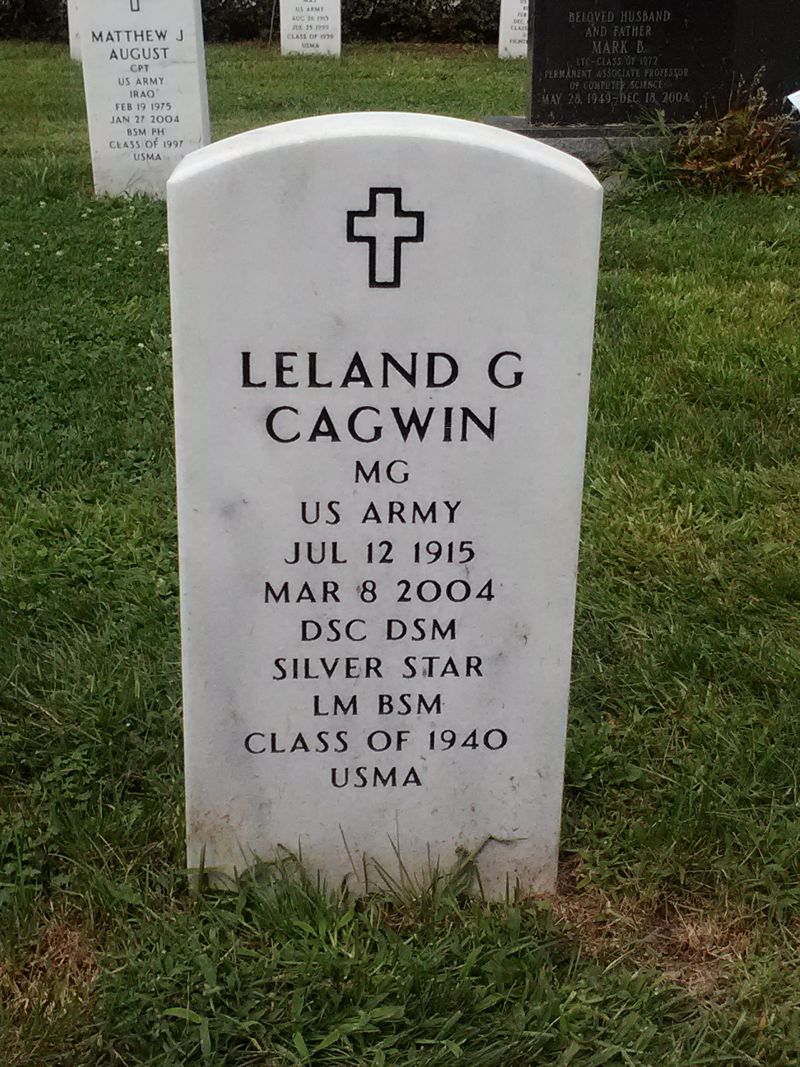Cagwin graduated from the New York Military Academy, and attened the Massachusetts Institute of Technology (MIT) prior to being appointed to the United States Military Academy, Class of 1940. One year later he married Jacqueline Smith at St. John's Chapel in Monterey, California. Shortly after their marriage, Cagwin was assigned to Schofield Barracks, Hawaii. He was with the 35th Infantry Regiment (The Cacti), 25th Infantry Division, when the Japanese attacked on December 7, 1941. Throughout World War II, General Cagwin remained with the 35th Regiment in the South and Southwest Pacific, rising from company commander, then battalion commander, and finally regimental commander. Cagwin captured the first prisoner of war on Guadacanal, where he was awarded the Distinguished Service Cross (Citation reads: Captain Leland G. Cagwin, Infantry, distinguished himself by extraordinary heroism in January 1943 at Guadacanal in an attack upon an enemy bivouac area when the members of the patrol began to hesitate because of heavy enemy fire. Captain Cagwin advanced to the front and led the men against the enemy held ridge they were storming. In spite of heavy fire from automatic weapons the patrol cut through the defense, captured one 77mm gun and one heavy machine gun, and killed 78 enemy soldiers. The following day, January 16, he lead a second patrol into an enemy controlled area, personally killilng five enemy soldiers, and leading in the rout of the opposing forces. On a third occassion, Captain Cagwin lead a small patrol into another enemy bivouac area, and personally captured an enemy noncommissioned offier, who furnished information for ruther action.").
General Cagwin graduated from the National War College in 1957. He was assigned as Special Assistant to the Chief of Staff, Supreme Headquarters Allied Powers Europe (SHAPE) in Paris. His assignments ranged from Korea to France, Ethiopia, and Germany where in 1969 he became the Director of Operations of the U.S. European Command.
General Cagwin retired in 1973 after 33 years of service.
General Cagwin's citations and decorations include the Distinguished Service Cross, Distinguished Service Medal with 2/d Oak Leaf Cluster, Silver Star, Legion of Merit w/two Oak Leaf Clusters, Bronze Star Medal, Distinguished Unit Citation w/2d Award Republic of Korea, and Order of National Security Merit Third Class.
General Cawin's swervice medals indlude: American Defense Medal, Asiatic-Pacific Campaign Medal, Philippine Liberation Ribbon, Philippine Indepence Ribbon, World War II Victory Medal, Koeran Service Medal, United Nations Service Medal, National Defense Service Medal w/Oak Leaf Cluster, Armed Forces Expeditory Medal, Philipinne Presidental Unit Citation, and Republic of Korea Presidental Unit Citation.
In retirement, Cagwin pursued his love of photography, and won an award in Kodak composition. Additionally, he headed the TSA proram at the Monterey Institute of International Studies, where he was on the Board. He was with the Carmel Foundation, Monteryey Museum of Art, The Friends of the San Antonio Mission Preservation and was on the Vestry of St. John's Chapel.
Predeceased by son Timothy D. Cagwin (1946-1998).
Cagwin graduated from the New York Military Academy, and attened the Massachusetts Institute of Technology (MIT) prior to being appointed to the United States Military Academy, Class of 1940. One year later he married Jacqueline Smith at St. John's Chapel in Monterey, California. Shortly after their marriage, Cagwin was assigned to Schofield Barracks, Hawaii. He was with the 35th Infantry Regiment (The Cacti), 25th Infantry Division, when the Japanese attacked on December 7, 1941. Throughout World War II, General Cagwin remained with the 35th Regiment in the South and Southwest Pacific, rising from company commander, then battalion commander, and finally regimental commander. Cagwin captured the first prisoner of war on Guadacanal, where he was awarded the Distinguished Service Cross (Citation reads: Captain Leland G. Cagwin, Infantry, distinguished himself by extraordinary heroism in January 1943 at Guadacanal in an attack upon an enemy bivouac area when the members of the patrol began to hesitate because of heavy enemy fire. Captain Cagwin advanced to the front and led the men against the enemy held ridge they were storming. In spite of heavy fire from automatic weapons the patrol cut through the defense, captured one 77mm gun and one heavy machine gun, and killed 78 enemy soldiers. The following day, January 16, he lead a second patrol into an enemy controlled area, personally killilng five enemy soldiers, and leading in the rout of the opposing forces. On a third occassion, Captain Cagwin lead a small patrol into another enemy bivouac area, and personally captured an enemy noncommissioned offier, who furnished information for ruther action.").
General Cagwin graduated from the National War College in 1957. He was assigned as Special Assistant to the Chief of Staff, Supreme Headquarters Allied Powers Europe (SHAPE) in Paris. His assignments ranged from Korea to France, Ethiopia, and Germany where in 1969 he became the Director of Operations of the U.S. European Command.
General Cagwin retired in 1973 after 33 years of service.
General Cagwin's citations and decorations include the Distinguished Service Cross, Distinguished Service Medal with 2/d Oak Leaf Cluster, Silver Star, Legion of Merit w/two Oak Leaf Clusters, Bronze Star Medal, Distinguished Unit Citation w/2d Award Republic of Korea, and Order of National Security Merit Third Class.
General Cawin's swervice medals indlude: American Defense Medal, Asiatic-Pacific Campaign Medal, Philippine Liberation Ribbon, Philippine Indepence Ribbon, World War II Victory Medal, Koeran Service Medal, United Nations Service Medal, National Defense Service Medal w/Oak Leaf Cluster, Armed Forces Expeditory Medal, Philipinne Presidental Unit Citation, and Republic of Korea Presidental Unit Citation.
In retirement, Cagwin pursued his love of photography, and won an award in Kodak composition. Additionally, he headed the TSA proram at the Monterey Institute of International Studies, where he was on the Board. He was with the Carmel Foundation, Monteryey Museum of Art, The Friends of the San Antonio Mission Preservation and was on the Vestry of St. John's Chapel.
Predeceased by son Timothy D. Cagwin (1946-1998).
Inscription
LELAN G
CAGWIN
MG
US ARMY
JUL 12 1919
MAR 8 2004
DSC DSM
SILVER STAR
LM BSM
CLASS OF 1940
USMA
Family Members
Sponsored by Ancestry
Advertisement
Records on Ancestry
Advertisement














